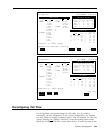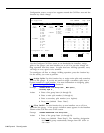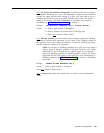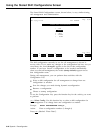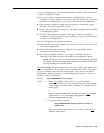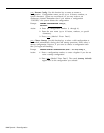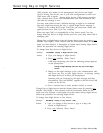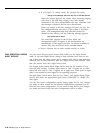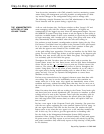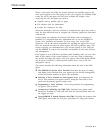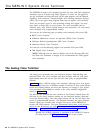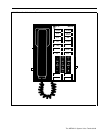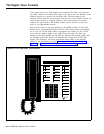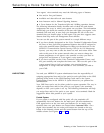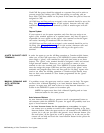
Day-to-Day Operation of CMS
Your day-to-day interaction with CMS primarily involves monitoring system
status during call management and using dynamic reconfiguration to make
any needed changes in the configuration being used to manage calls.
The following example illustrates how the CMS administrator at Bon Voyage
Travel interacts with the system during a typical day.
THE ADMINISTRATOR’S At 9 a.m. each business day, Pat Payne switches on Bon Voyage’s PC and
ACTIVITIES AT BON starts managing calls with the weekday configuration. All agents are
VOYAGE TRAVEL
automatically in the logged out state when call management begins. Pat uses
the MERLIN II system Group Page feature to ask the agents in some splits to
touch the Available button on their voice terminals to signal they are available
to begin answering calls. Another split is using a line group with Auto ACW;
they automatically become available when the calls start coming in.
Pat performs several dynamic reconfiguration activities during the day. First,
Pat removes Tom Baker from his position in the Personal Travel split because
he is on vacation. He moves a new agent into Tom’s position in that split,
and tells the agent to move himself to the Available state.
As the peak calling hour approaches, Pat turns on intraflow for the Public line
group. Pat uses the Group Page feature to tell the agents in the Support split
that they may now receive calls for the Public line group. The Support split
is a secondary split for the Public line group.
Throughout his shift, Pat takes time out from other work to monitor the
System Status screen, the Line Status screen, and the Split Status Information
screen. He can use the
[ ^ ] - [ Prt Sc ] keys to print any of these screens if he
wants to. The screens provide a detailed picture of activity throughout the
system. Using them, Pat can tell when to turn intraflow on or off, when a
new agent may be having trouble handling calls, or when all lines in a line
group are busy. Pat can use Dynamic Reconfiguration to correct these
situations as they occur.
Pat has set an external alert to be triggered whenever more than three calls
are waiting. This way he can be immediately aware of this condition no
matter where he is in the room. Also, agents are immediately aware of this
condition and know, without Pat telling them, that they have to move on to
the next calls quickly. Pat does have to take time out from other work to tell
them.
When Pat notices that three calls are waiting in the Charter Travel main split,
and there have been several abandoned calls. Pat turns on intraflow to allow
waiting calls to be sent to the Corporate Travel split (the secondary split for
the Charter line group). Pat also increases the answer delay (the length of
time calls ring before CMS answers them) so callers will spend a little less
time on hold.
Pat has a new agent in the Corporate Travel split, Yesterday, Pat spent time
with the new agent, explaining the voice terminal features he’ll be using. As
the new agent answers CMS calls for the first time, Pat watches the Split
Status screen to see when the new agent is on a call, and then monitors the
call. In this way, Pat is able to give the agent advice on handling calls.
Pat also looks at the Management Information System (MIS) reports to
determine if Bon Voyage Travel has an efficient number of lines and agents.
He prints some of the daily reports to review hourly call activity for the day
and prints cumulative daily and hourly reports to help develop a CMS profile
for his business.
Day-to-Day Operation of CMS 5-47



